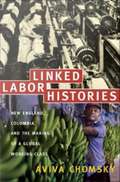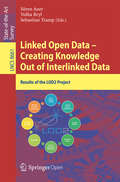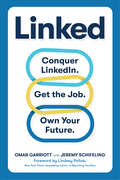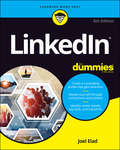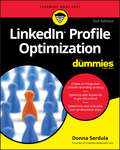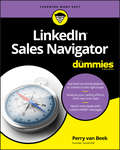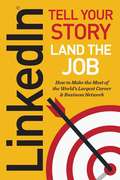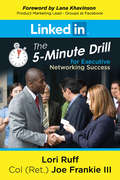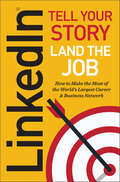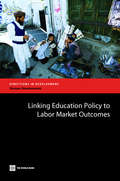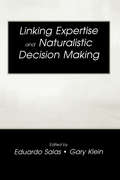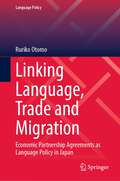- Table View
- List View
Linked Decisions: How to Plan Ahead by Effectively Coordinating Current and Future Decisions
by John S. Hammond Ralph L. Keeney Howard RaiffaMany important decisions require you to select now among alternatives that will greatly influence your decisions in the future. This chapter addresses an important element of effective decision making, illustrating how to deal more effectively with decisions that are linked over time.
Linked Labour Histories: New England, Colombia, and the Making of a Global Working Class
by Aviva ChomskyExploring globalization from a labor history perspective, Aviva Chomsky provides historically grounded analyses of migration, labor-management collaboration, and the mobility of capital. She illuminates the dynamics of these movements through case studies set mostly in New England and Colombia. Taken together, the case studies offer an intricate portrait of two regions, their industries and workers, and the myriad links between them over the long twentieth century, as well as a new way to conceptualize globalization as a long-term process. Chomsky examines labor and management at two early-twentieth-century Massachusetts factories: one that transformed the global textile industry by exporting looms around the world, and another that was the site of a model program of labor-management collaboration in the 1920s. She follows the path of the textile industry from New England, first to the U. S. South, and then to Puerto Rico, Japan, Mexico, Central America, the Caribbean, and Colombia. She considers how towns in Rhode Island and Massachusetts began to import Colombian workers as they struggled to keep their remaining textile factories going. Most of the workers eventually landed in service jobs: cleaning houses, caring for elders, washing dishes. Focusing on Colombia between the 1960s and the present, Chomsky looks at the Urab banana export region, where violence against organized labor has been particularly acute, and, through a discussion of the AFL-CIO's activities in Colombia, she explores the thorny question of U. S. union involvement in foreign policy. In the 1980s, two U. S. coal mining companies began to shift their operations to Colombia, where they opened two of the largest open-pit coal mines in the world. Chomsky assesses how different groups, especially labor unions in both countries, were affected. Linked Labor Histories suggests that economic integration among regions often exacerbates regional inequalities rather than ameliorating them.
Linked Open Data -- Creating Knowledge Out of Interlinked Data
by Sören Auer Volha Bryl Sebastian TrampLinked Open Data (LOD) is a pragmatic approach for realizing the Semantic Web vision of making the Web a global, distributed, semantics-based information system. This book presents an overview on the results of the research project "LOD2 -- Creating Knowledge out of Interlinked Data". LOD2 is a large-scale integrating project co-funded by the European Commission within the FP7 Information and Communication Technologies Work Program. Commencing in September 2010, this 4-year project comprised leading Linked Open Data research groups, companies, and service providers from across 11 European countries and South Korea. The aim of this project was to advance the state-of-the-art in research and development in four key areas relevant for Linked Data, namely 1. RDF data management; 2. the extraction, creation, and enrichment of structured RDF data; 3. the interlinking and fusion of Linked Data from different sources and 4. the authoring, exploration and visualization of Linked Data.
Linked: Conquer LinkedIn. Get Your Dream Job. Own Your Future.
by Omar Garriott Jeremy SchifelingThe LinkedIn insider&’s guide to how the new job search really works—and how to make it work for you. No one disputes that LinkedIn is the world&’s biggest job market. So it&’s about time that someone with the inside scoop explained how to make the most of it. Here, from two LinkedIn experts and former employees, is the definitive guide that demystifies the massive site and gives every reader—from the newly minted college graduate to the midlife career-changer—the most important strategies to win the modern job search game. Clear, lively, and decidedly practical, Linked shows how to burnish your personal brand so recruiters come to you. Tap the power of the network effect and turn anyone into an invaluable referral. Think like employers and focus your profile to get noticed, get considered, and get hired. And game both the search algorithm and Applicant Tracking Systems used by nearly every employer in every economic sector. The result: not just a great job, but the future of your dreams.
LinkedIn (A)
by Mikolaj Jan PiskorskiIn the summer of 2005, LinkedIn, a two-year-old start-up, was choosing between two options to monetize its 5 million business people network. Members could contact each other through trusted intermediaries on the network to offer or seek jobs, consulting engagements, expertise, and financing. The company had outpaced its competitors by building the most populous online business network, but it had little revenue to show its investors. The first revenue option entailed keeping the existing features unchanged and rolling out a bundle of eight new services for a monthly fee of $15. These services would be targeted at network members who had forged many connections, logged in frequently, and viewed the profiles of many other members. The second proposal involved changing a basic design feature of LinkedIn by allowing members to contact each other without intermediaries for a fee. Fewer members would avail themselves of this feature, but those who did would be willing to pay as much as $5-$15 per message. This option ran a substantial risk of alienating members and would prompt some to abandon LinkedIn.
LinkedIn Corp., 2008
by David B. Yoffie Michael Slind Nitzan AchsafIn June 2008, the online professional networking service LinkedIn became a $1 billion company. But CEO Dan Nye understood that LinkedIn faced several strategic dilemmas. Founded in 2002, LinkedIn by 2008 had become the world's leading professional networking service (PNS), with more than 23 million members. Aiming to "dominate the business of business networking," in Nye's words, LinkedIn allowed individual members to post a profile on the LinkedIn site and then to use the site's tools to search for job opportunities; to recruit job candidates; to find suppliers, partners, and customers; and to seek out expert advice. The company was also expanding into corporate services that would enable companies to build and manage their own online networks. With revenue sources that included advertising, premium subscriptions, job posting services, and business solutions, LinkedIn was on track to bring in revenues in 2008 of up to $100 million. A new funding round in mid-2008 yielded a $1 billion valuation for the company. Three key dilemmas confronted LinkedIn, however. First, at a time when the "walled garden" model of online community building was under siege, it had to decide how far it should open its platform to users. Second, in light of competition from highly popular social network services such as Facebook and MySpace, LinkedIn had to decide whether to incorporate social networking into its value proposition. Third, in an increasingly global business environment, it had to weigh the option of merging with its leading international competitor, XING.com.
LinkedIn Corporation
by James Weber Francois BrochetThe purpose of this case is to help students critically evaluate the market value of LinkedIn's stock following its recent IPO. In the context of strong investor appetite for social media companies, LinkedIn is the lamp bearer among U.S. companies in that industry that are considering tapping into public markets. The case can serve to illustrate the challenges of valuing an early-stage high-growth company with a great deal of uncertainty about fundamental value and how quoted prices might reflect expectations that are hard to justify. Regardless of which valuation method is employed (e.g., residual income, discounted cash flow, multiples), the case provides a platform (i) to map the firm's key success and risk factors into forecasts and estimates for its future performance and cost of capital, and (ii) to critically assess the implied assumptions underlying the market's expectations. The case is best suited for a course on business valuation at all levels (undergraduate, MBA, executive programs).
LinkedIn Corporation, 2012
by David B. Yoffie Liz KindSince its inception in 2003, LinkedIn had become a leading Silicon Valley institution with a brand name that was recognizable throughout the U.S. and in many countries overseas. As of March 2012, LinkedIn was the world's largest professional network on the Internet with $522.2 million in revenue in 2011 and more than 150 million members in over 200 countries. Unlike other major social networking sites, LinkedIn focused exclusively on fostering connections within the professional market. As LinkedIn's CEO thought about the future, he recognized the challenges in continuing to massively scale the company. At the same time, he focused on how LinkedIn could continue to use its vast amount of data to provide additional products and services for its members and customers.
LinkedIn For Dummies
by Joel EladMake LinkedIn your number one professional branding tool LinkedIn is the premiere social network for professionals looking to discover new opportunities, enhance personal branding, connect with other professionals, and make career advancements. With LinkedIn For Dummies, you’ll have step-by-step instructions on how to take advantage of the latest tools and features to do all of this and more. This book will teach you how to create an attractive profile that employers will notice, as well as ways to expand your network by making connections around the globe. You'll also learn how to best navigate the new user interface, write recommendations, take a course with LinkedIn Learning, and conduct your job search. Create an appealing, detailed profile Establish your credibility and personal brand Connect with employers and find jobs Request and write recommendations Whether you’re one of LinkedIn’s 500 million global members or brand new to the site, this authoritative resource helps you get the most out of the world’s largest professional network.
LinkedIn For Dummies
by Joel EladBrand yourself like a pro on LinkedIn LinkedIn multiplies what you know by the power of who you know to deliver the number one social platform for business professionals and new job seekers. LinkedIn For Dummies shows LinkedIn newcomers the best ways to discover new opportunities, enhance their personal brand, network with other professionals, and give an exponential boost to their career. Consider this book a passport to help you connect more successfully with many of LinkedIn’s 660+ million members in over 200 countries, as well as an expert guide to the platform’s tools and features and the proven tactics that get you noticed. In this friendly, all-access introduction to the LinkedIn scene, entrepreneurship guru Joel Elad clues you in on the essentials. Get the latest insight on how to create an attractive profile that will make employers give you a second glance as well as techniques for making useful connections across the globe. In no time at all you’ll also be right at home with the profile user interface and getting busy with adding content, searching for career opportunities, and, if you’re looking to hire for your company, recruiting top candidates. Build your personal brand and market it Sell yourself by highlighting skills, awards, and endorsements Get connected with LinkedIn groups Manage and make introductions via InMail Relationships matter: LinkedIn For Dummies gives you the online social skills to turn six degrees of separation into the colleagues, mentors, and friends who will transform your career—and your life.
LinkedIn Profile Optimization For Dummies
by Donna SerdulaOptimize your LinkedIn profile--and get results Your LinkedIn profile is essentially a platform to shape how others see you, highlight your abilities, products, or services, and explain how your work impacts lives. Yet many people simply copy and paste their resume and expect job offers and networking opportunities to start rolling in--but that isn't how it works. LinkedIn Profile Optimization For Dummies shows you how to create a profile that enhances your personal brand, controls how others see you, and shapes a successful future for your career. Whether your goal is job search, branding, reputation management, or sales, people are Googling you--and your LinkedIn profile is more often than not their first point of contact. With a focus on who you are, the value you deliver, and the culture you cultivate, the profile you'll create with the help of this guide will make that first connection a positive one--giving you a better chance to see results. Create a powerful LinkedIn profile Discover your personal keywords Showcase your experience and accomplishments Be seen on the world's largest professional social network You never get a second chance to make a great first impression, and LinkedIn Profile Optimization For Dummies helps to ensure you're presenting yourself in the best possible light.
LinkedIn Profile Optimization For Dummies
by Donna SerdulaGive your LinkedIn profile the makeover it deserves—and get the attention you deserve Look at your profile: you know it could be a little better. Too many LinkedIn users are just posting a basic resume and hoping for the offers to come flooding in, missing out on the incredible opportunity the platform offers to properly showcase their talents, products, and services to 610 million professionals in over 200 countries. LinkedIn is way more than a resume tool—to display your professional past and present—it’s also your career future and personal brand. Used to its fullest extent, it helps you demonstrate the unique value and culture you provide, the skills and aspirations that make you different, to get the outcomes you truly want. But how’s it done? Profile branding expert Donna Serdula pioneered the concept of LinkedIn Profile Optimization and through her Website, LinkedIn-Makever.com, has helped over 5000 professionals use LinkedIn to achieve increased success. In this guide she applies that experience to help you use all of LinkedIn’s capabilities to meet your goals, whether they be job search, reputation management, or sales—including how to: Create a memorable, successful profile Optimize personal keywords Showcase your experience, accomplishments, and unique value Use LinkedIn features to grow your network and more You never get a second chance to make a first impression—and people are Googling you right now: Get a fresh online look and get results!
LinkedIn Sales Navigator For Dummies
by Perry Van BeekMake selling a social affair! The ABCs of sales have changed. It's no longer: A-Always, B-Be, C-Closing. The new way of selling is: A-Always, B-Be, C-Contributing to your buyer's journey. Social selling is an effective way to engage with your customer, and the world's most powerful social selling tool for any B2B sales professional is LinkedIn Sales Navigator. It allows you to gain access to more leads, more InMail, and data to track your efforts. With the help of LinkedIn Sales Navigator For Dummies, you'll learn how to write effective InMail messages and engage with prospects on the world's most successful professional networking site. Along with utilizing those features, you'll also benefit from access to full profiles outside of your network, guidance on how to best optimize your own profile for sales opportunities, and much more. Use lead recommendations to get in front of the right buyer Analyze your social selling efforts with real-time data Reach more leads with customized InMail messages Save 30 - 60 minutes a day previously spent on acquisitions If you're a B2B sales professional who is new to LinkedIn Sales Navigator, this is the one-stop resource you can't be without.
LinkedIn: Tell Your Story, Land the Job
by Jeff Norman<p>Meet the World's Largest Career and Networking Site: LinkedIn <p>LinkedIn is dominating the world of business-based networking, yet many of its users don't know how to make the most of it, while others are hesitant to join yet another social network. Whether you're a job seeker, an employer in search of new talent, or a business looking to boost your visibility, make LinkedIn your social network of choice, this book your guide. <p><i>LinkedIn: Tell Your Story, Land the Job</i> will help you: <p> <li>Learn tips and tricks for building a strong LinkedIn profile, optimized for discovery <li>Write a concise professional summary, gather endorsements and recommendations, and highlight your skills <li>Create a virtual hub for current and potential employees and customers <li>Take advantage of LinkedIn's Company Pages to improve your visibility <li>Dig deeper into LinkedIn's offerings, by getting the most out of introduction requests, advanced search, media tools, and professional groups <li>Explore the pros and cons of the free vs. paid versions of LinkedIn</li> <p> <p>Dust off your LinkedIn Profile and make it shine with this visual, easy-to-follow handbook.</p>
LinkedIn: The 5-Minute Drill for Executive Networking Success
by Lori Ruff Joe FrankieLinkedIn: The 5-Minute Drill for Executive Networking Success is written for executives and transitioning military leaders to see the immediate benefit of using LinkedIn to network, build better teams, land new opportunities, pivot, change sectors, get promoted, and better merchandise their talents, expertise, and skill sets.Executives are busy people and LinkedIn is an extremely valuable resource. Once leaders know how to use LinkedIn for their desired purpose, they can quickly organize a 5-minute drill to accomplish their desired goals. LinkedIn represents the collaboration of two successful thought leaders, Lori Ruff and Joe Frankie III, both of whom have consulted with and crafted profiles for hundreds of executives since the early days of LinkedIn. They provide recommendations for representing oneself online as well as advice on how to navigate a daily routine for executives and leaders to keep themselves in sight and top of mind to people looking for someone just like them. Whether someone is representing their company or themselves, online image does matter and Lori and Joe show readers how to achieve online networking success.
LinkedIn® In One Hour for Lawyers
by Dennis Kennedy Allison C. ShieldsLawyers work in a world of networks, connections, referrals, and recommendations. For many lawyers, the success of these networks determines the success of their practice. LinkedIn®, the premier social networking tool for business, can help you create, nurture, and expand your professional network and gain clients in the process. LinkedIn® in One Hour for Lawyers provides an introduction to this powerful tool in terms that any attorney can understand
Linkedin: Tell Your Story, Land the Job
by Jeff NormanMeet the World's Largest Career and Networking Site: LinkedInLinkedIn is dominating the world of business-based networking, yet many of its users don't know how to make the most of it, while others are hesitant to join yet another social network. Whether you're a job seeker, an employer in search of new talent, or a business looking to boost your visibility, make LinkedIn your social network of choice, this book your guide.LinkedIn: Tell Your Story, Land the Job will help you: Learn tips and tricks for building a strong LinkedIn profile, optimized for discovery Write a concise professional summary, gather endorsements and recommendations, and highlight your skills Create a virtual hub for current and potential employees and customers Take advantage of LinkedIn's Company Pages to improve your visibility Dig deeper into LinkedIn's offerings, by getting the most out of introduction requests, advanced search, media tools, and professional groups Explore the pros and cons of the free vs. paid versions of LinkedIn
Linking Education Policy to Labor Market Outcomes
by Tazeen Fasih'Linking Education Policy to Labor Market Outcomes' examines current research and new evidence from Ghana and Pakistan-representative of two of the poorest regions of the world-to assess how education can increase income and help people move out of poverty. This study indicates that in addition to early investments in cognitive and noncognitive skills-which produce a high return and lower the cost of later educational investment by making learning at later ages more efficient-quality, efficiency, and linkages to the broader macro-economic context also matter. Education and relevant skills are still the key determinants of good labor market outcomes for individuals. However, education policies aimed at improving skills will have a limited effect on the incomes of that skilled workforce or on the performance of a national economy if other policies that increase the demand for these skills are not in place. For education to contribute to national economic growth, policies should aim at improving the quality of education by spending efficiently and by adapting the basic and postbasic curricula to develop the skills increasingly demanded on the global labor market, including critical thinking, problem solving, social behavior, and information technology.
Linking Employee Satisfaction to Business Results (Studies on Industrial Productivity: Selected Works)
by Paula S. TopoloskyFirst Published in 2000. Routledge is an imprint of Taylor & Francis, an informa company.
Linking Expertise and Naturalistic Decision Making (Expertise: Research and Applications Series)
by Gary Klein Eduardo SalasThis book contains selected papers presented at the 1998 conference on Naturalistic Decision Making (NDM). The objectives of the conference were to: *make American researchers more aware of NDM research being conducted abroad, particularly in Europe; *connect NDM research with work in management and industry, to stretch beyond the military and paramilitary focus; and *formulate a more explicit connection between NDM and expertise. These objectives are reflected in the chapters of this volume.
Linking Global Trade and Human Rights
by Daniel Drache Lesley A. JacobsDuring the global economic crisis of 2008, countries around the world used national policy spaces to respond to the economic crisis in ways that shed new light on the possibilities for linkages between international trade and human rights. This book introduces the idea of policy space as an innovative way to reframe recent developments in global governance. It brings together a wide-ranging group of leading experts in international law, trade, human rights, political economy, international relations, and public policy who have been asked to reflect on this important development in globalization. Their multidisciplinary contributions provide explanations for why the global landscape for national policy space has changed, clearly illustrate instances of this change, and project the future paths for policy development in social and economic policy spaces, especially with reference to linkages between international trade and human rights in countries from the Global North as well as Brazil, China, and India.
Linking Health and Education for African American Students' Success
by Nadine M. Finigan-CarrThe linkages between a student’s health and a student’s ability to learn have been well established. Children who are sick stay home; and, children at home cannot learn if they are not in school leading to increased dropout rates among other educational outcomes. However, an understanding of this concept is just the beginning of understanding how education and public health are inextricably linked. In light of this, Linking Health and Education for African American Students’ Success examines health disparities and education inequities simultaneously and moves beyond a basic understanding of health and education in K-12 school programs. The structural inequalities which lead to reduced academic attainment mirror the social determinants of health. Education is one of the most powerful determinants of health, and disparities in educational achievement as a result of structural inequalities closely track disparities in health. These disparities lead to both sub-standard healthcare and reduced academic attainment among children from underserved minorities in the United States, especially African Americans. This book discusses how this may result in children with poorer mental health outcomes; higher school dropout rates; increased risks of arrests and incarceration; higher rates of chronic diseases and mortality; and overall diminished opportunities for success, while providing suggestions as to how to address these issues. This results in an insightful read for researchers, academics and practitioners in the fields of healthcare and education.
Linking Industries Across the World: Processes of Global Networking (Routledge Revivals)
by Eike W. SchampOriginally published in 2005. This book examines how regional industries use different networks on various geographical scales in order to withstand increasing competition in a globalising world. It argues that new forms of global governance of networked industries are emerging, in particular in those areas that have only recently been incorporated into the global economy such as Eastern Europe, Asia and Southern Africa. The book addresses a number of issues, including the different forms of institutional arrangements that contribute to the formation of heterogeneous global industrial networks. It also raises the issue of national institutions that still matter in network formation. The focus of the book is on how to improve regional and sectoral competitiveness in a global context and it suggests this is best achieved by a close analysis of global linkages, an evolutionary perspective on processes taking place, and a more differentiated view on globalisation.
Linking Language, Trade and Migration: Economic Partnership Agreements as Language Policy in Japan (Language Policy #33)
by Ruriko OtomoThis book examines the effect of trade policy on language which represents an underrecognized area in the field of language policy and planning. It argues that trade policies like Japan’s Economic Partnership Agreements (EPAs) have important consequences for national language (education) policies and for discourses about language and nation. Since 2008, Japan has signed the EPAs with Indonesia, the Philippines and Vietnam to recruit migrant nurses and eldercare workers and manage their mobility by means of pre-employment language training and the Japanese-medium licensure examinations. Through the analysis of these language management devices, this book demonstrates that the EPAs are a manifestation and representation of contemporary language issues intertwined particularly with pressing issues of Japan’s social aging and demographic change. As the EPAs are intertwined with welfare, economy, social cohesion, and international political and economic relations and competitiveness, the book presents a far more complex picture of and a richer potential of language policy.

